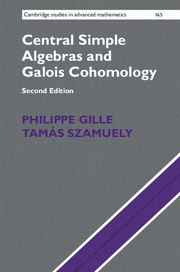Book contents
- Frontmatter
- Contents
- Preface
- 1 Quaternion algebras
- 2 Central simple algebras and Galois descent
- 3 Techniques from group cohomology
- 4 The cohomological Brauer group
- 5 Severi–Brauer varieties
- 6 Residue maps
- 7 Milnor K-theory
- 8 The Merkurjev–Suslin theorem
- 9 Symbols in positive characteristic
- Appendix: a breviary of algebraic geometry
- Bibliography
- Index
Preface
Published online by Cambridge University Press: 07 August 2017
- Frontmatter
- Contents
- Preface
- 1 Quaternion algebras
- 2 Central simple algebras and Galois descent
- 3 Techniques from group cohomology
- 4 The cohomological Brauer group
- 5 Severi–Brauer varieties
- 6 Residue maps
- 7 Milnor K-theory
- 8 The Merkurjev–Suslin theorem
- 9 Symbols in positive characteristic
- Appendix: a breviary of algebraic geometry
- Bibliography
- Index
Summary
This book provides a comprehensive and up-to-date introduction to the theory of central simple algebras over arbitrary fields, emphasizing methods of Galois cohomology and (mostly elementary) algebraic geometry. The central result is the Merkurjev–Suslin theorem. As we see it today, this fundamental theorem is at the same time the culmination of the theory of Brauer groups of fields initiated by Brauer, Noether, Hasse and Albert in the 1930s, and a starting point of motivic cohomology theory, a domain which is at the forefront of current research in algebraic geometry and K-theory – suffice it here to mention the recent spectacular results of Voevodsky, Suslin, Rost and others. As a gentle ascent towards the Merkurjev–Suslin theorem, we cover the basic theory of central simple algebras, methods of Galois descent and Galois cohomology, Severi–Brauer varieties, residue maps and, finally, Milnor K-theory and K-cohomology. These chapters also contain a number of noteworthy additional topics. The last chapter of the book rounds off the theory by presenting the results in positive characteristic. For an overview of the contents of each chapter we refer to their introductory sections.
Prerequisites. The book should be accessible to a graduate student or a nonspecialist reader with a solid training in algebra including Galois theory and basic commutative algebra, but no homological algebra. Some familiarity with algebraic geometry is also helpful. Most of the text can be read with a basic knowledge corresponding to, say, the first volume of Shafarevich's text. To help the novice, we summarize in an appendix the results from algebraic geometry we need. The first three sections of Chapter 8 require some familiarity with schemes, and in the proof of one technical statement we are forced to use techniques from Quillen K-theory. However, these may be skipped in a first reading by those willing to accept some ‘black boxes’.
Acknowledgments
Our first words of thanks go to Jean-Louis Colliot-Thélène and Jean-Pierre Serre, from whom we learned much of what we know about the subject and who, to our great joy, have also been the most assiduous readers of the manuscript, and suggested many improvements. Numerous other colleagues helped us with their advice during the preparation of the text, or spotted inaccuracies in previous versions.
- Type
- Chapter
- Information
- Central Simple Algebras and Galois Cohomology , pp. ix - xiiPublisher: Cambridge University PressPrint publication year: 2017

